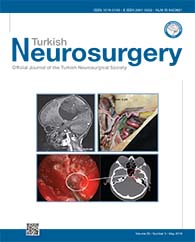2Ufuk University School of Medicine, Department of Neurosurgery, Ankara, Turkey
3Ankara University School of Medicine, Department of Histology and Embriology, Ankara, Turkey DOI : 10.5137/1019-5149.JTN.24764-18.2 AIM: To demonstrate progression of acute and chronic endocrinopathies in a kaolin-induced hydrocephalus model using light microscopy.
MATERIAL and METHODS: Adult male SpragueâDawley rats (n = 48) were divided into six groups. Hydrocephalus was induced by intracisternal injection of kaolin solution in the acute and chronic kaolin groups, whereas an identical volume of sterile saline was injected into the sham groups.
RESULTS: Somatotropic cell concentrations were lower in the kaolin groups compared with their controls, but there was no difference in somatotropic cell concentration between the acute and chronic kaolin groups. Corticotropic cell concentrations were higher in the acute kaolin and sham groups compared with acute controls. Thyrotropic cell numbers were higher in the acute sham and kaolin groups compared with their controls, and although thyrotropic cell concentations were higher in the acute kaolin group than the acute sham group. No differences were observed between the acute and chronic controls and sham and kaolin groups regarding mammotropicand gonadototropic cell concentations.
CONCLUSION: Somatotropic cells are most affected by hydrocephalus that causes pituitary dysfunction, and this effect was more prominent under acute and chronic phases.
Keywords : Hydrocephalus, Endocrinopathy, Kaolin, Pituitary dysfunction, Rat




